Have you ever looked at a flight path on a map and wondered why airplanes take curved routes instead of flying in a straight line? Wouldn’t flying in a direct line be more fuel-efficient and faster? At first glance, it seems logical that a shorter distance would result in less fuel consumption, but in reality, aviation is far more complex.
Several factors determine flight paths, including the Earth’s shape, jet streams, weather conditions, and air traffic regulations. Let’s break down why airplanes rarely fly in a straight line and how their curved paths actually make flights more efficient.
The Earth’s Shape and the Great Circle Route

One of the biggest reasons airplanes don’t fly in a straight line is the Earth’s curvature. While we often view flight maps as flat, the Earth is a sphere, and the shortest path between two points is actually an arc called the Great Circle Route.
If you take a globe and use a string to connect two distant locations, you’ll notice that the shortest route often curves rather than follows a straight path. This is why flights from New York to Tokyo pass over the Arctic region rather than flying directly west across the Pacific Ocean.
Using the Great Circle Route helps planes save both time and fuel, even though it appears curved on a flat map.
Jet Streams and Weather Conditions Impact Flight Paths
Another key factor affecting airplane routes is jet streams—high-altitude wind currents that move at speeds of up to 200 mph (320 km/h). Pilots strategically plan routes to take advantage of these strong winds when possible.
Video : Why Airplanes Don’t Fly Straight
Flying with jet streams allows an airplane to get an extra push, helping it move faster while burning less fuel. Flying against a jet stream can slow down the plane significantly, increasing fuel consumption. Pilots often adjust routes to avoid strong headwinds, even if it means flying a longer distance.
Additionally, storms, turbulence, and severe weather conditions also play a role in determining flight paths. Airplanes may adjust mid-flight to bypass dangerous weather zones, thunderstorms, or areas with extreme turbulence.
Air Traffic Control and Flight Regulations
Air traffic isn’t a free-for-all where planes can just fly wherever they want. There are strict regulations set by aviation authorities and air traffic control (ATC) that dictate flight routes.
Some of these rules include restricted airspace, where certain areas, such as military zones, national security locations, and political zones, prohibit commercial flights from entering. Predefined flight corridors exist to avoid mid-air collisions, ensuring flights follow established air traffic lanes. Major airports handle hundreds of flights daily, so ATC ensures safe and efficient arrivals and departures.
Due to these regulations, airplanes cannot always take the most direct path and must follow designated routes instead.
Avoiding Air Turbulence for Passenger Comfort
Turbulence can make a flight uncomfortable, and pilots actively adjust routes to minimize rough air conditions. There are different types of turbulence, including thermal turbulence caused by warm air rising from the ground. Flying at higher altitudes helps avoid this.

Mechanical turbulence happens near mountains and rough terrains where wind patterns shift unpredictably. Clear-Air Turbulence (CAT) is sudden, strong air currents in high altitudes that are difficult to predict.
To ensure a smoother ride for passengers, pilots may deviate from the shortest path to avoid these turbulent areas.
Why Do Airplanes Sometimes Ascend Before Landing?
If you’ve ever been on a flight where the plane suddenly climbs just before landing, you might have felt a bit concerned. This maneuver is known as a go-around and is actually a common and safe aviation practice.
Some reasons why pilots perform a go-around include runway clearance issues. If another plane hasn’t cleared the runway in time, pilots must abort the landing and circle back. Poor weather conditions, such as poor visibility, strong crosswinds, or sudden gusts, can make a landing unsafe. If a plane is too fast, too high, or not properly aligned with the runway, the pilot will ascend and try again for a safer landing.
Go-arounds are standard procedures in aviation and ensure passenger safety above all else.
The World’s Longest Non-Stop Flight
While most flights follow curved paths, some routes push the limits of non-stop travel. The longest direct commercial flight in the world is from Singapore to Newark, New Jersey, USA.
This flight covers a distance of 10,400 miles (16,700 km) and takes approximately 18 hours and 45 minutes. It follows a carefully optimized path to balance fuel efficiency, wind conditions, and passenger comfort.
Video : Does Earth’s Rotation affect the Airplanes Speed & Flight Time
What Happens If a Plane Suddenly Loses Cabin Pressure?
A sudden drop in cabin pressure is often portrayed as a dramatic event in movies, but in reality, pilots are well-trained to handle it calmly.
When this happens, oxygen masks automatically deploy, and passengers should put them on immediately and breathe normally. The plane will descend to a safe altitude where oxygen levels are sufficient for breathing. The flight crew will assess the situation and communicate with passengers.
Losing cabin pressure doesn’t mean the plane will crash—pilots follow strict safety protocols to handle such incidents efficiently.
Final Thoughts: Why Curved Flight Paths Are More Efficient
While it may seem counterintuitive, airplanes take curved routes instead of straight lines to optimize flight efficiency, fuel usage, and passenger safety. Factors such as the Earth’s shape, jet streams, air traffic control, and weather conditions all play a crucial role in determining flight paths.
So next time you’re on a plane and see the route map displaying a curved flight path, remember there’s a lot of science and planning behind it to ensure you reach your destination as safely and efficiently as possible.
Meu vizinho copiou tudo o que eu fiz até que descobri o motivo de partir o coração – História do dia

Mudei-me para uma fazenda em ruínas que tinha acabado de herdar, esperando paz. Mas quando meu vizinho copiou minha cerca amarela, não tinha ideia de que era apenas o começo de algo muito mais profundo e pessoal.
Cresci em uma família adotiva que fazia o melhor que podia. Eles eram gentis e pacientes, sempre preparavam meu lanche e aplaudiam nas peças da minha escola, mesmo quando eu ficava no fundo usando uma fantasia de árvore de papelão.
Mas o amor verdadeiro é mais do que refeições quentes e aplausos educados. É… saber de onde você vem.

Apenas para fins ilustrativos | Fonte: Pexels
Ninguém nunca me contou nada sobre meus pais biológicos. Os jornais disseram que pediram total confidencialidade. Nenhum nome. Nenhum aniversário. Nenhuma história. Apenas um espaço em branco onde algo grande deveria estar.
Eu costumava sonhar que talvez eles fossem espiões. Ou estrelas do rock. Ou perdidos em algum lugar na selva. Qualquer coisa era melhor do que pensar que eles não se importavam.

Apenas para fins ilustrativos | Fonte: Pexels
Cresci rápido. Aos 15, eu já distribuía panfletos do lado de fora de shoppings.
Aos 16, eu passeava com cachorros para pessoas que mal lembravam do meu nome. Aos 18, eu servia café para clientes regulares mal-humorados que davam gorjetas e conselhos de vida que eu não pedia.
“Você deveria se casar com alguém rico, querida. Você tem olhos gentis.”

Apenas para fins ilustrativos | Fonte: Midjourney
Aos 19, eu era um barista oficial com um crachá torto e pedidos de bebidas memorizados. Então vieram mais empregos. Cuidador. Carteiro. Jardineiro. Por um tempo, eu até mesmo recolhi animais atropelados na estrada.
Não pergunte. Não, sério, não pergunte.
Eu sabia como sobreviver. Mas parecia que a má sorte estava no meu DNA.
Aos 27, consegui o emprego de escritório dos meus sonhos. Um salário estável. Fins de semana de folga. Parecia uma vitória.

Apenas para fins ilustrativos | Fonte: Midjourney
No mesmo dia, fiquei doente. Seis meses de exames, médicos dando de ombros.
“Pode ser estresse.”
É, não estou brincando.
Aos 30, virei babá. A outra babá alegou que eu roubei dinheiro da família. Eu não roubei, mas fui demitida. Fiquei do lado de fora do prédio com uma mala, meu fundo de emergência enfiado no bolso do meu casaco e um olhar distante.
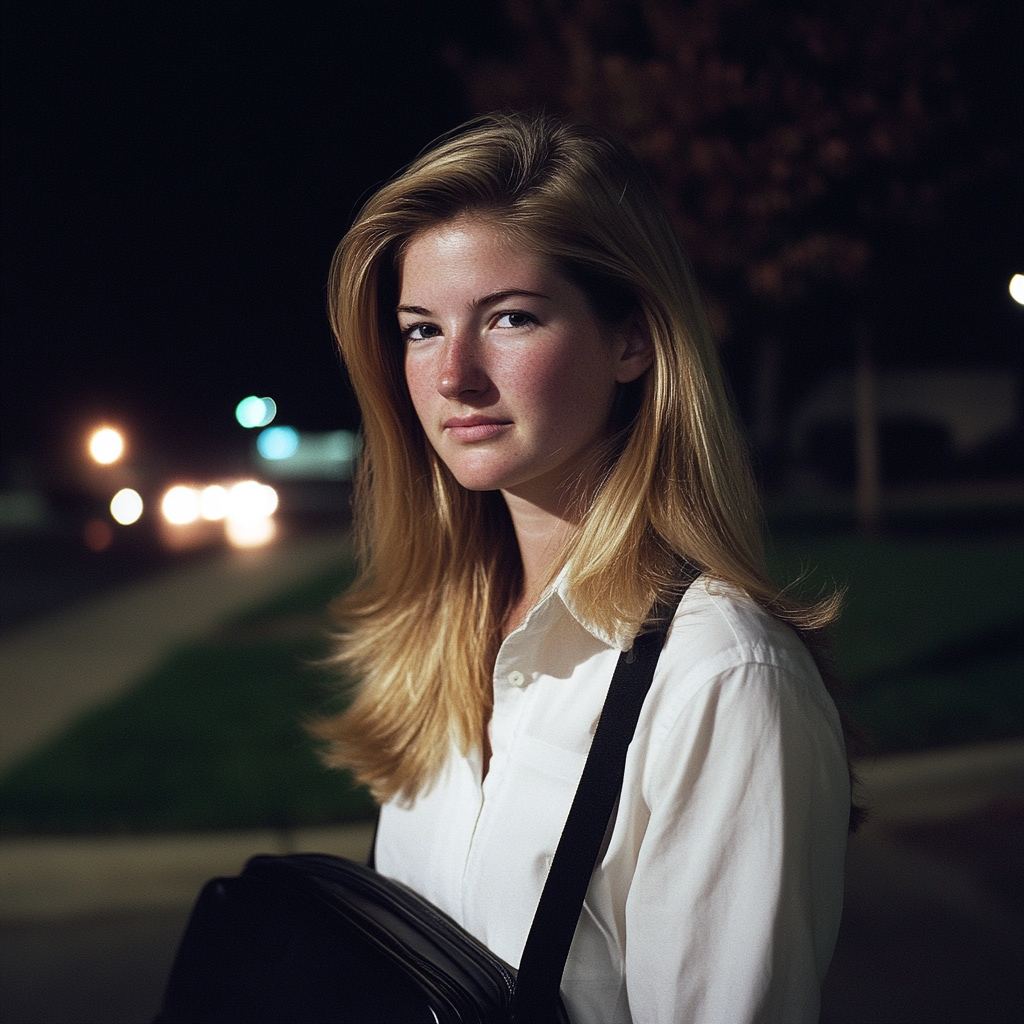
Apenas para fins ilustrativos | Fonte: Midjourney
Então meu telefone tocou.
“Ellie? É Jake, o advogado do seu pai,” disse uma voz calorosa.
“Meu quem?”
“Seu pai, Henry. Ele faleceu recentemente. Você foi nomeado o único herdeiro da fazenda dele. Fica a cerca de 30 quilômetros da cidade. Você pode pegar as chaves amanhã.”

Apenas para fins ilustrativos | Fonte: Midjourney
“Uma fazenda?”, repeti. “Um pai?”
“Biológico,” ele disse gentilmente. “Eu explicarei mais pessoalmente.”
Não dormi um minuto naquela noite. Eu tinha um pai. Ele me deixou um lar. Pela primeira vez na minha vida, algo me pertencia.

Apenas para fins ilustrativos | Fonte: Midjourney
***
Quando cheguei à fazenda, sentei-me ali por um minuto, olhando para a casa, os campos, o silêncio. Uma pergunta circulava na minha cabeça como uma mosca que não me deixava em paz.
Por que ele deixou isso comigo?
A casa parecia cansada. Tinta lascada descascava das paredes e ervas daninhas cobriam o quintal. Mas então eu vi o celeiro. Estava limpo. A tinta vermelha era fresca e as portas eram retas e sólidas. Parecia orgulhoso.
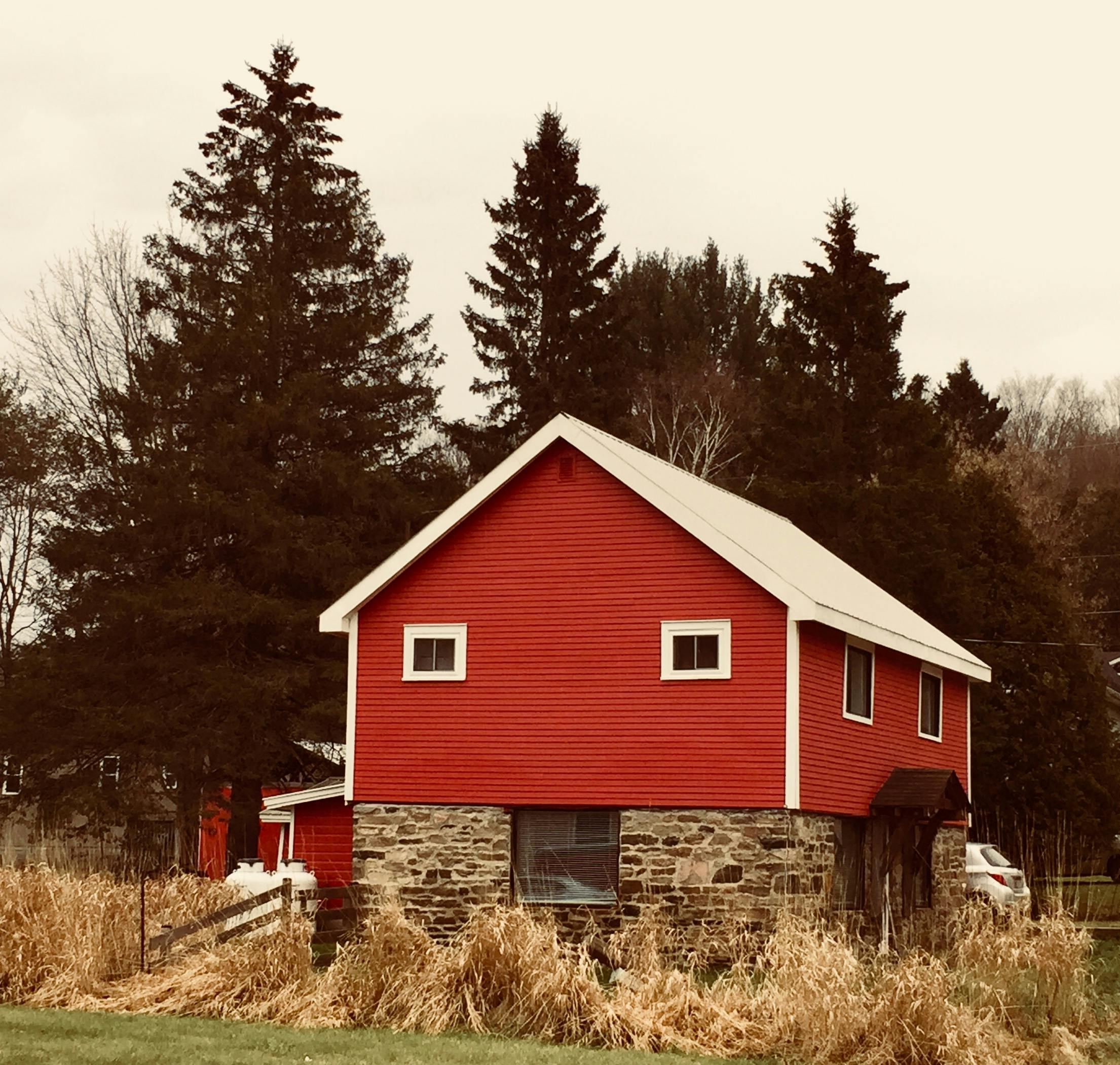
Apenas para fins ilustrativos | Fonte: Pexels
Curioso, entrei. O cheiro de feno me atingiu primeiro. O chão estava varrido. Pilhas organizadas de feno enfileiravam-se nas paredes.
Uma fileira de ovos frescos estava em uma cesta como se alguém tivesse acabado de coletá-los. Um balde de água brilhava no canto, limpo o suficiente para beber.
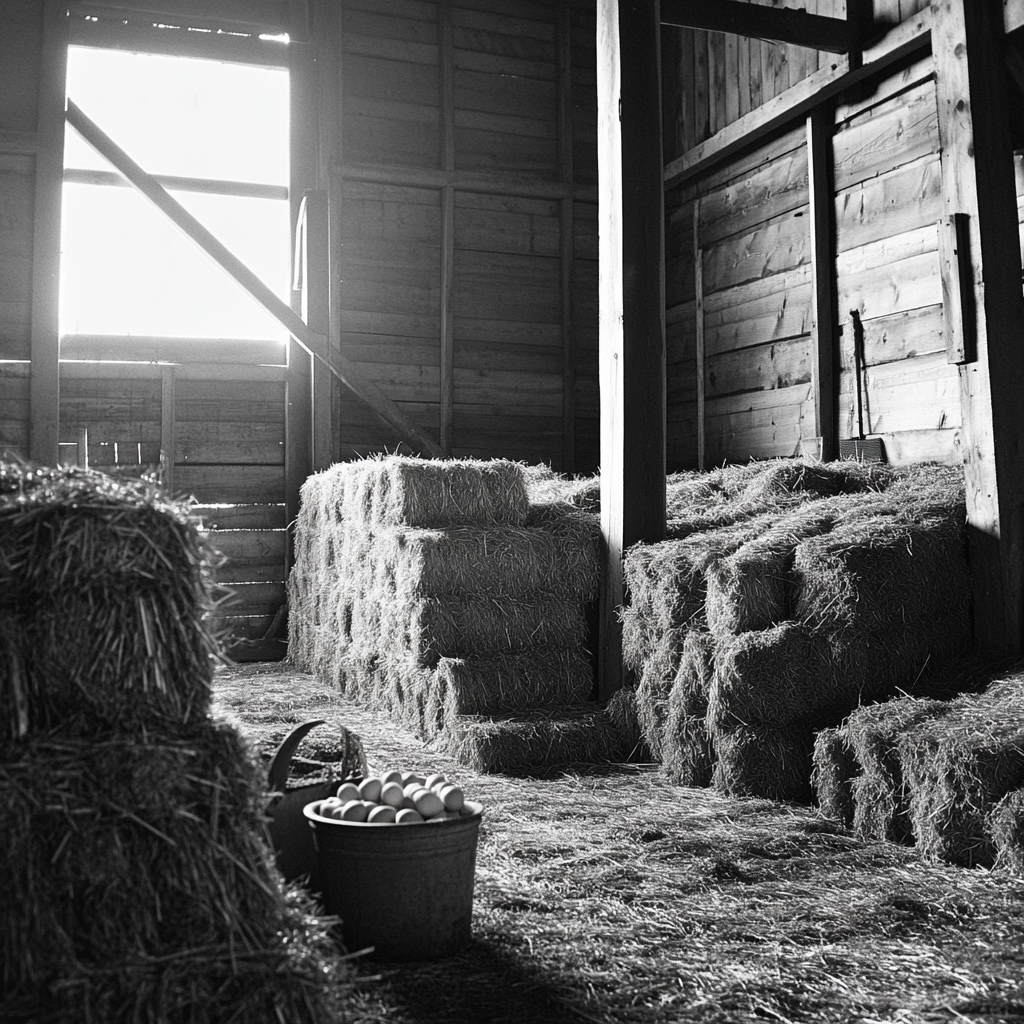
Apenas para fins ilustrativos | Fonte: Midjourney
E então havia os animais. Galinhas cacarejavam suavemente, bicando a palha. Uma grande vaca marrom e branca estava calmamente parada, piscando para mim.
O cachorro era a parte mais estranha. Ele estava sentado perto da porta como se estivesse me esperando. Seu pelo estava um pouco desgrenhado. Eu me agachei.
“Vem cá, garoto…”

Apenas para fins ilustrativos | Fonte: Pexels
Ele trotou até mim e lambeu minha mão como se nos conhecêssemos há anos.
“Ok, estranho”, eu disse suavemente, olhando ao redor. “Quem tem alimentado você?”
Já fazia uma semana que meu pai havia falecido.
Então… quem está cuidando de tudo isso? Devem ser os vizinhos.

Apenas para fins ilustrativos | Fonte: Midjourney
Deixei minha bolsa perto da porta e olhei ao redor dentro da casa. Poeira flutuava através da luz do sol como flocos de neve preguiçosos.
Na parede estava pendurada uma única foto. Um homem na casa dos 50 anos. Seus olhos eram calorosos. Meu peito doía só de olhar para ele — meu pai.
Sentei no chão e olhei ao redor. Eu não conhecia aquele homem. Não conhecia aquela fazenda. Mas, de alguma forma, eu não estava com medo. Eu fiquei.

Apenas para fins ilustrativos | Fonte: Midjourney
***
Toda manhã, eu acordava com um propósito. Consertei a cerca, pintei a varanda e aprendi a coletar ovos sem ser bicada.
Eu não tinha certeza de como, mas eu simplesmente sabia o que fazer. Era como se algo dentro de mim tivesse clicado — um interruptor secreto.
“Modo Fazendeiro LIGADO.”
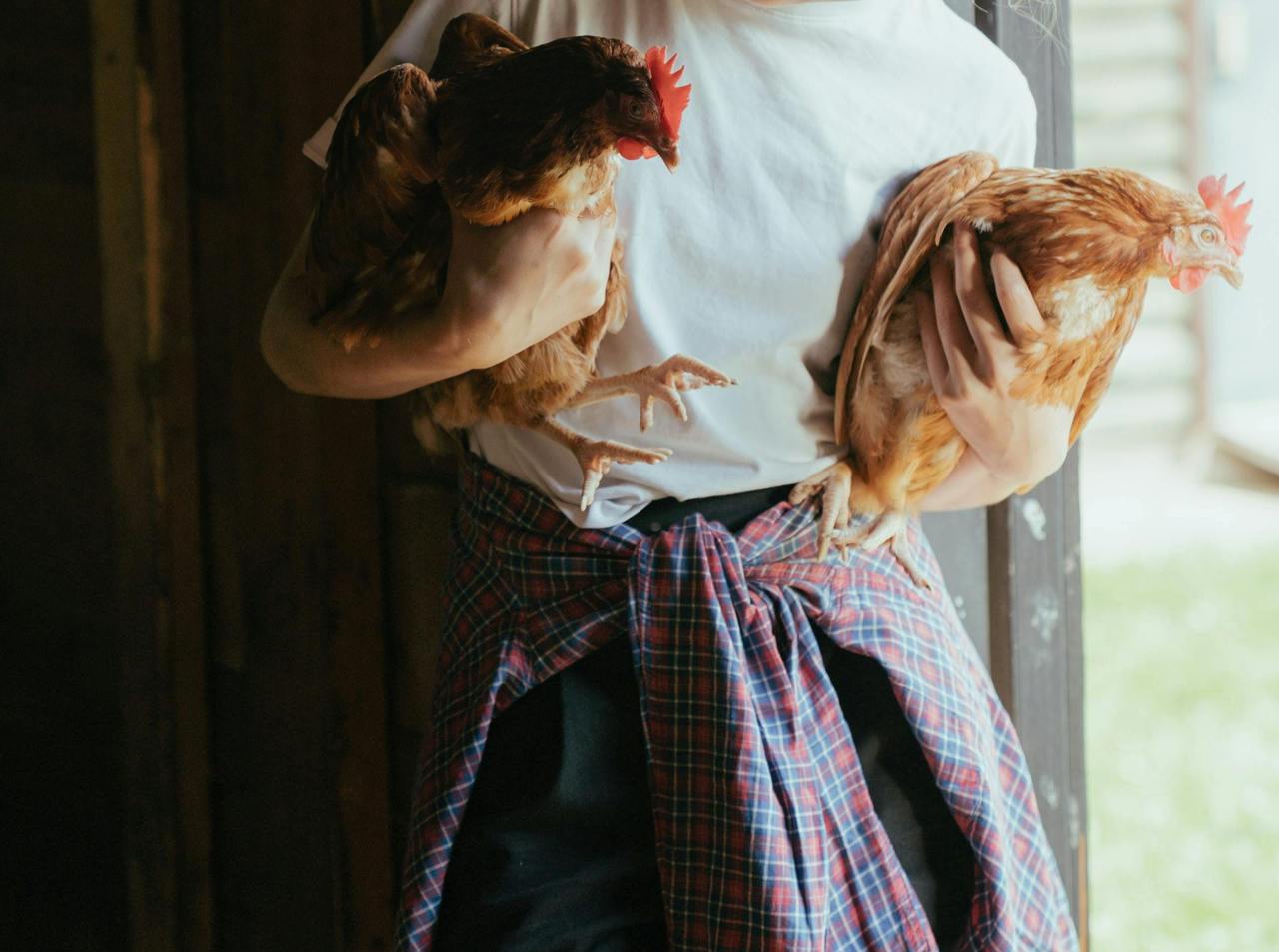
Apenas para fins ilustrativos | Fonte: Pexels
Mas quando comecei a me sentir em casa, ela apareceu.
Linda. Minha vizinha.
No começo, pensei que ela era apenas tímida. Depois, pensei que ela era um pouco estranha.
Então, ela… começou a copiar tudo que eu fazia. Foi aí que as coisas começaram a ficar estranhas.

Apenas para fins ilustrativos | Fonte: Midjourney
***
“O que…?”
Fiquei paralisada na janela da cozinha, com uma colher de cereal a meio caminho da boca.
No dia anterior, eu tinha pintado minha cerca de amarelo brilhante. Era a única lata de tinta que eu encontrei no galpão, e eu estava com orçamento apertado. A tinta tinha um cheiro horrível, mas a cerca parecia alegre.
Naquele momento, olhando para o outro lado da divisa da propriedade, vi a cerca de Linda. Também era amarela, do mesmo tom.

Apenas para fins ilustrativos | Fonte: Midjourney
“Talvez seja apenas uma coincidência.”
No dia seguinte, construí uma nova caixa de correio. Fiquei orgulhoso dela — de madeira, com um pequeno telhado inclinado e um passarinho entalhado sentado em cima. Levei a tarde toda e três Band-Aids.
Dei um passo para trás e disse em voz alta: “Você acertou em cheio, Ellie.”
Na manhã seguinte, eu saí… e lá estava. A caixa de correio de Linda. Mesma forma. Mesmo telhado. Exatamente o mesmo pássaro.

Apenas para fins ilustrativos | Fonte: Midjourney
“Você só pode estar brincando”, murmurei, segurando minha xícara de café.
Tentei ser educado e acenei para Linda quando a vi lá fora. Ela nunca acenou de volta — apenas correu para o celeiro dela como se eu a tivesse pego fazendo algo ilegal.
Mas então vieram as margaridas. Elas eram minhas favoritas. Plantei-as em uma linha curva perto da minha escada da frente.
Na manhã seguinte?

Apenas para fins ilustrativos | Fonte: Midjourney
Linda tinha as mesmas margaridas. Mesma curva. A mesma fileira de pedras ao redor delas. Saí e fiquei olhando para o quintal dela.
Ela está me observando? Me copiando de propósito?
Tentei ignorar isso até a aula de ioga.
Em uma manhã ensolarada, rolei meu tapete na grama e comecei minha rotina habitual. Apenas alguns alongamentos para relaxar.

Apenas para fins ilustrativos | Fonte: Midjourney
Quando olhei, Linda estava cambaleando exatamente na minha pose.
Ela estava usando jeans e um chapéu de aba larga. Ela estava copiando novamente.
Foi isso. Minha paciência se foi. Eu marchei pelo quintal e bati no portão de madeira dela.
“Ei, Linda! Precisamos conversar!”

Apenas para fins ilustrativos | Fonte: Midjourney
A porta rangeu ao abrir lentamente. Ela ficou ali, parada, silenciosa. Seus olhos escuros encontraram os meus. Arregalados. Sérios. Um pouco assustados.
“Por que você está copiando tudo o que eu faço? O que você quer de mim?!”
Ela não respondeu. Apenas deu um passo para trás e assentiu levemente.
Eu a segui para dentro de casa. Foi quando eu os vi.
Cartas. Dezenas delas. Espalhadas sobre a mesa. Todas endereçadas a mim.

Apenas para fins ilustrativos | Fonte: Pexels
“Quem são esses?”
Ela pegou o de cima e me entregou. Seus dedos tremeram. Eu o abri.
“Minha querida Ellie,
Não sei como falar com você. Não sei se você ao menos quer ouvir.
Mas eu sou… sua mãe. Eu vivi perto do seu pai. Nós nunca fomos oficialmente divorciados, mas vivíamos separados. Quando você nasceu, eu era… diferente.
Eu tenho autismo.

Apenas para fins ilustrativos | Fonte: Pexels
A vida me sobrecarregou. Seu pai decidiu que seria melhor se uma família estável e amorosa o criasse. Mas eu sempre soube sobre você. E quando ele morreu, eu cuidei da fazenda. E então você veio…
Eu não sabia como me aproximar de você nem como falar.
Então comecei a fazer o que você fez.
Era a minha maneira… de estar perto.”

Apenas para fins ilustrativos | Fonte: Midjourney
Reli a carta. E de novo.
“Você…” Eu olhei para cima.
Ela ficou parada, mal respirando. Peguei outra carta — uma mais antiga. Uma foto caiu. A jovem Linda segurava uma criança, ambas sorrindo.
“É isto…?”

Apenas para fins ilustrativos | Fonte: Pexels
“Essa é minha filha. Ellie.”
“Meu?”
“Minha filha”, ela repetiu suavemente. “Você é Ellie.”
De repente… Não sei por que, mas… Virei-me e corri. De volta ao meu quintal. Passei pelas margaridas. Passei pela caixa de correio.
E eu chorei. Eu não sabia como consertar nada, e não sabia se estava pronta para isso.

Apenas para fins ilustrativos | Fonte: Midjourney
***
Alguns dias se passaram.
Fiquei dentro de casa. Nada de leitura, nada de café, nada de regar as margaridas. Só fiquei deitado no sofá, observando sombras rastejarem pelo teto, esperando que elas soletrassem algo que fizesse sentido.
Eu não estava doente. Não de uma forma que qualquer médico pudesse curar. Era o tipo de dor que enche seu peito e faz tudo parecer… leve e pesado ao mesmo tempo.

Apenas para fins ilustrativos | Fonte: Pexels
Pensei que saber a verdade traria paz.
Mas em vez de um encerramento, eu encontrei uma mãe. E de alguma forma, isso me desvendou mais do que todos os anos que passei me perguntando.
Então, uma manhã, eu abri a porta da frente. Uma pilha de cartas — envelopes grossos amarrados com barbante — estava quieta na minha porta.

Apenas para fins ilustrativos | Fonte: Midjourney
Levei-os para dentro com mãos trêmulas. Cada envelope estava marcado com um ano. Uma carta para cada ano da minha vida. Trinta cartas.
Eu li o primeiro. Depois, o segundo. Depois, todos eles.
Cada um deles foi escrito à mão em uma caligrafia limpa e cuidadosa. Alguns tinham desenhos. Outros tinham pétalas secas enfiadas dentro. Todos estavam cheios de emoção, admiração, tristeza… e amor.

Apenas para fins ilustrativos | Fonte: Pexels
Tanto amor.
Linda me escrevia todo ano — em aniversários, primeiros dias de escola que eu nunca contei a ela, e faculdade que ela nem sabia que eu nunca tinha terminado. Ela imaginava tudo, enviando desejos para o vazio.
Eu chorei em cada página. Solucei. Porque pela primeira vez na minha vida, não me senti esquecida.

Apenas para fins ilustrativos | Fonte: Midjourney
Na terceira manhã, abri a porta novamente.
Os canteiros de flores foram regados. Os animais foram alimentados. O quintal parecia recém-varrido.
Um bilhete dobrado estava escondido debaixo de um pote de geleia deixado na varanda.
“Guardei o leite na minha geladeira.
Com amor, mamãe”

Apenas para fins ilustrativos | Fonte: Midjourney
Mãe.
Segurei o bilhete em minhas mãos e olhei fixamente para aquela palavra.
Pela primeira vez, não pareceu imaginário. Eu tinha uma mãe — uma mulher quieta, complicada e desajeitada que demonstrava amor não por meio de palavras, mas por meio de cartas e gestos.
E eu percebi… talvez não tenha sido ela quem falhou comigo. Talvez tenha sido a situação. A maneira como a vida se desfez antes que qualquer um de nós pudesse mantê-la unida.

Apenas para fins ilustrativos | Fonte: Pexels
A culpa do papai agora vive comigo: nestas paredes, nesta terra, no silêncio que ele deixou para trás. Mas eu tenho o poder de reescrever o final.
Naquele momento, tomei uma decisão. Saí para o sol da manhã. Descalço, como sempre.
Linda estava em seu quintal, cambaleando em uma pose de ioga sem entusiasmo, seu chapéu de sol quase caindo sobre seus olhos. Mas ela estava tentando — ainda tentando.

Apenas para fins ilustrativos | Fonte: Midjourney
Meu coração doeu. Andei em direção à cerca.
“Essa é… a pose do guerreiro. Eu também não sou muito fã.”
Ela congelou, então se virou lentamente. Um pequeno e tímido sorriso surgiu em seus lábios.
“Você está indo muito bem”, acrescentei. “Mas você se sairá melhor sem o chapéu.”

Apenas para fins ilustrativos | Fonte: Midjourney
Ela o tirou, alisou a aba com os dedos e o colocou gentilmente na grama. Então, ela se moveu para a pose da árvore. Ela cambaleou e caiu de lado.
Eu realmente ri, pela primeira vez em dias.
“Ok”, eu disse, me aproximando da cerca. “Vamos fazer um acordo. Eu vou te mostrar uma pose, e você tenta. Mas… chega de cópias de caixa de correio.”

Apenas para fins ilustrativos | Fonte: Midjourney
“Tudo bem”, ela sussurrou.
“Você se sairá melhor se relaxar os dedos.”
E nós ficamos ali — nós dois — finalmente do mesmo lado do quintal, sob o mesmo céu. Um pouco desajeitados. Um pouco inseguros. Mas não mais sozinhos.

Apenas para fins ilustrativos | Fonte: Midjourney
Mais tarde, fizemos chá na minha casa. Apontei para a foto da carta dela.
“Essa foto… é você?”
Ela assentiu.
“E minha filha Ellie. Somos você e eu.”
“Li todas as cartas. Obrigada, mãe.”

Apenas para fins ilustrativos | Fonte: Pexels
Ela agarrou sua xícara de chá com ambas as mãos.
“Posso… tentar aquela pose amanhã? Aquela com a perna no ar?”
Eu assenti. Nós dois sorrimos. Então rimos. E de alguma forma, parecia que a vida estava encontrando sua cor novamente.
E sabe de uma coisa?
Aquela cerca amarela não parecia mais tão estranha. Talvez fosse o começo. Assim como nós.

Apenas para fins ilustrativos | Fonte: Midjourney
Diga-nos o que você acha dessa história e compartilhe com seus amigos. Pode inspirá-los e alegrar o dia deles.
Se você gostou desta história, leia esta: Minha vida não era emocionante ou cheia de significado até que… um tsuru de papel em uma calçada molhada parecia exatamente com aqueles que meu pai dobrou antes de desaparecer há vinte e cinco anos.
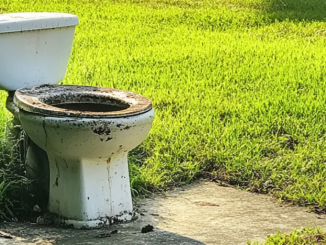


Leave a Reply